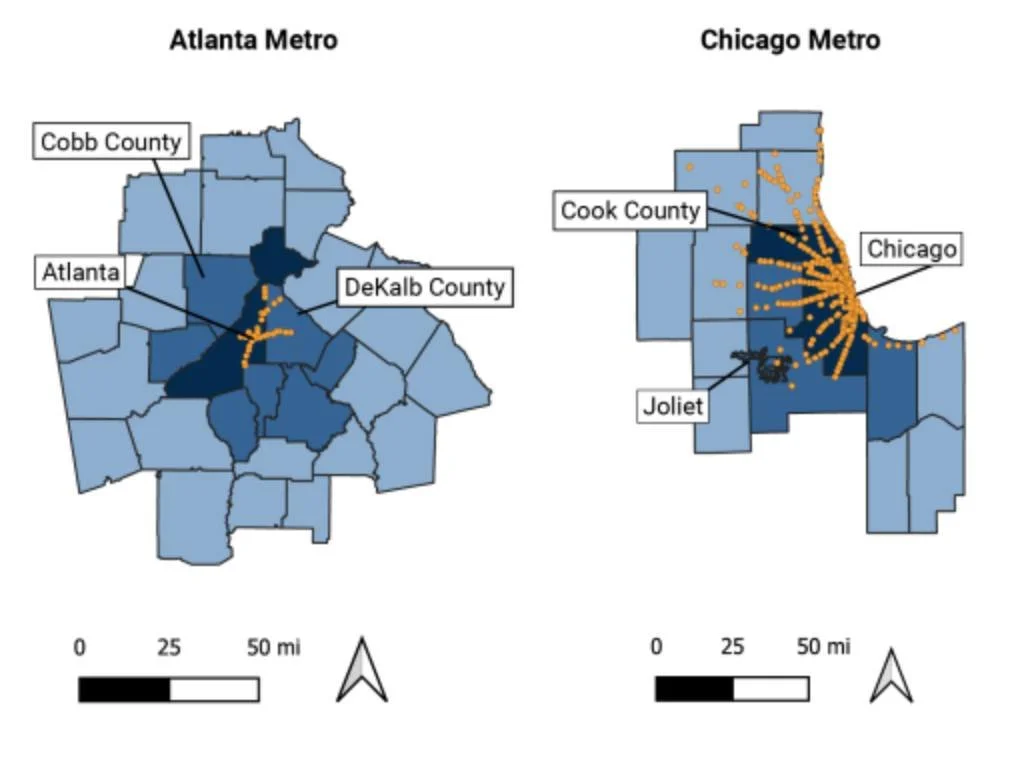For climate resilience, Atlanta needs to better match transit & density
A new Brookings report looks at three metro areas -- Atlanta, Chicago, and D.C. -- to make an important point: we need to vastly improve connectivity between urban development and transit expansion. The failures of the past on that count have contributed to climate issues.
The limited reach of heavy-rail transit in Atlanta compared to Chicago is striking (these maps are at an even scale).
Atlanta and Chicago
At the same scale, the limited reach of rail in the Atlanta metro, versus Chicago, is clear
From the report:
"The Department of Transportation should require all local and state agencies that receive federal funding for public transportation to coordinate transit investments with land use. Why spend money building subway, light rail, or bus rapid transit systems in locations that prohibit moderate-density mixed-use housing and commercial development?"
It's a good thing to look out for as Atlanta moves forward with plans for a Summerhill Bus Rapid Transit line, and another one on Campbellton Road (assuming that will be the choice there, versus light rail). And also as we plan to extend the streetcar onto the Eastside Beltline.
Is Atlanta putting a significant amount of our new urban development near these planned transit lines, or will those lines be surrounded by a problematic amount of lower-density urbanism that doesn't support transit? Is Atlanta adding much of its density in places where there's no clear path forward for transit expansion?
Beyond the City of Atlanta, there's a plan for BRT on the top end of I-285 and elsewhere, and MARTA will be pursuing BRT into Clayton County (following the loss of a rail option this year, after the use of freight lines was denied). Are those new lines going to be matched with urban growth, putting people and jobs near transit?
The Brookings report is mainly looking at this need for matching transit with compact, walkable styles of development from a climate perspective.
> Building homes near job centers and public transportation reduces vehicle miles traveled—a major source of GHG emissions.
> Mixed-use development that integrates housing with stores, restaurants, and services allows people to run daily errands and socialize by walking or cycling instead of driving.
> Small homes—including townhouses, duplexes, and apartments in multifamily buildings—use less energy than single-family detached homes.
The climate impact of car-centric sprawl is real, especially when there's little option other than driving for every trip. You've likely seen the old image comparing metro Atlanta's car-scaled growth with Barcelona. As noted in a Washington Post article on this issue: "The more spread-out an urban area, the more likely its residents are to run even the most routine errands by car, producing vehicle emissions. The more compact it is, the less distance residents need to travel every day, and the easier — and cheaper — it is to build public transit."
Atlanta and Barcelona
Source:
We'll add that there's a major equity concern here as well. We need to make sure our transit investments are coupled with opportunities for more people to have multi-modal access to jobs and more, with an emphasis on affordability for lower-income groups. Walkable, transit-served growth that's only affordable for the wealthy isn't good enough.



